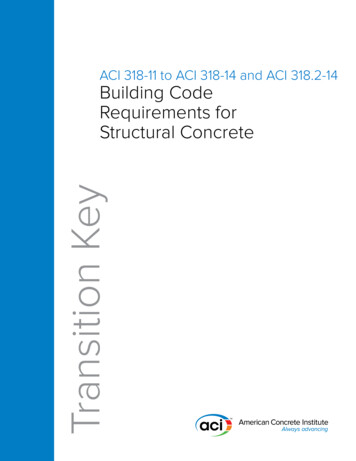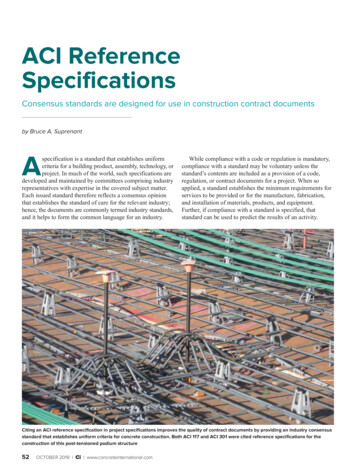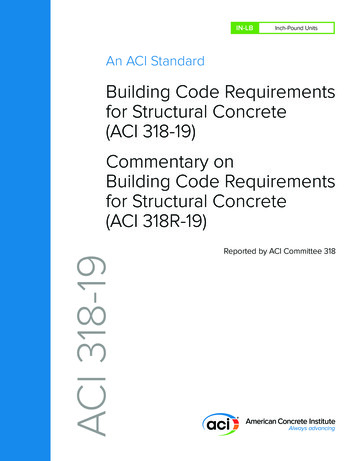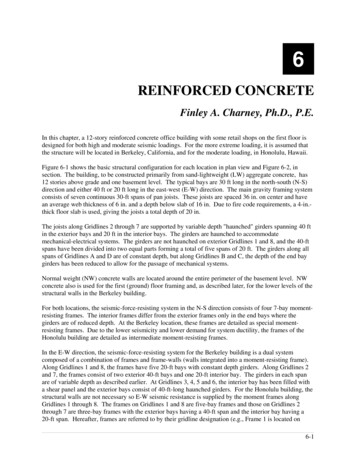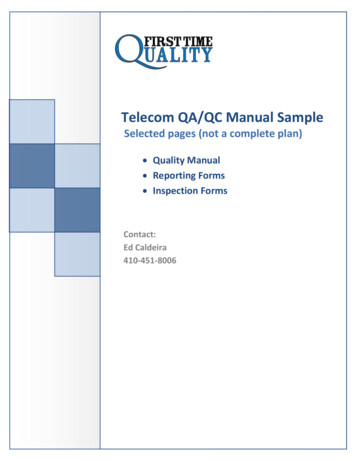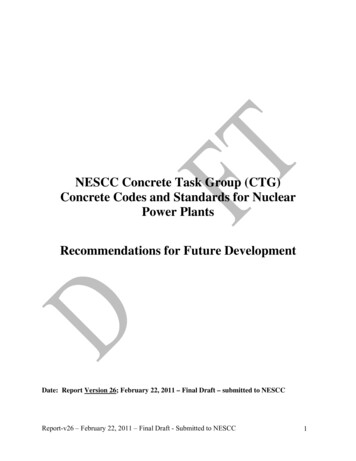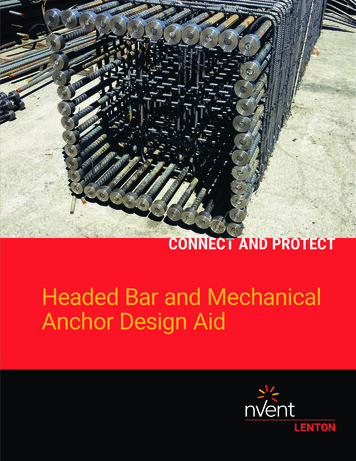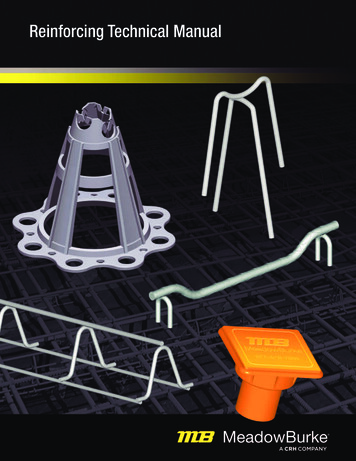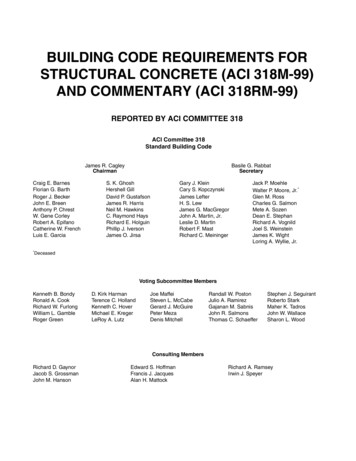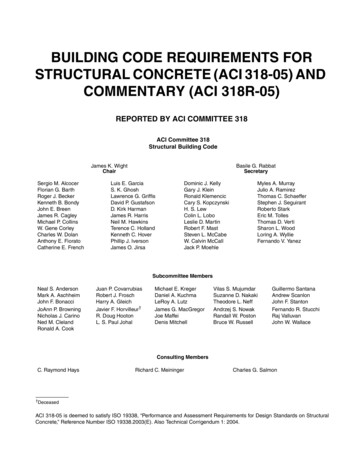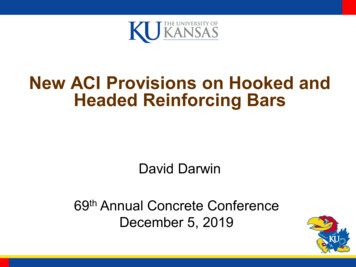
Transcription
New ACI Provisions on Hooked andHeaded Reinforcing BarsDavid Darwin69th Annual Concrete ConferenceDecember 5, 2019
Outline ACI 318-14 Provisions and Basis forProvisions Scope of Studies What We’ve Learned Comparison of Test Data with ACI 31814 Design Approach in ACI 318-19 Things We Need to Work On
Emphasis on high-strength reinforcingsteel but full range of bar stresses studied Anchorage of High-Strength ReinforcingBars with Standard Hooks Anchorage of High-Strength ReinforcingBars with Heads
Sponsors
ACI 318-14 Equations f y ψe ψc ψr 50λ f ′c db Hooks: dh Heads: 0.016 f y ψ e dt db ′fc
Modification factors Epoxy-coated reinforcement:ψ e 1.2 Cover*:ψ c 0.7 Confining reinforcement*:ψ r 0.8 Lightweight concrete*:λ 0.75 Excess reinforcement*:* Hooks only( As required )( As provided )ACI 318-14
Limitations on f c′ and f y and Head Size Hooks: Heads:f c′ 10,000 psi; f y 80,000 psif c′ 6, 000 psi; f y 60,000 psiAbrg 4AbACI 318-14
Limitations on bar spacing Headed bars: Cover as required for straight bars Clear spacing – horizontal layer Clear spacing – vertical layers 2db 4db 4d bACI 318-14
Design Equations in ACI 318-19 Hooks: dh f y ψe ψr ψo ψc 55λ f ′c 1.5 db Heads: f y ψe ψ p ψo ψc dt 75 f ′c 1.5 db
Basis for ACI 318-14 Provisions forHooked Bars38 tests of standardhooked bars that failed inbondConcrete strength 3.8 –5.1 ksiYield strengths 64 and 68ksi
Basis for ACI Provisions for Headed Bars 100 splice, side and shallowblowout, and CCT node tests Concrete strength 3.5 – 5.5 ksi Yield strength 69 ksi Normalweight concrete
Scope of Studies Test Specimens Range of Variables
Test Specimens
Beam-Column Joints
Test Apparatus
Hooked and Headed Bar SpecimensHooked BarsHeaded Bars
Multiple Hook and Headed Bar TestSpecimens
Slab tests – Headed Bars
CCT Node Tests – Headed Bars eh eh
Splices – Headed Bars
Range in VariablesParametersRangeBar SizeNo. 5, 6, 8, 11Hook Bend Angle90 , 180 Head Size, Abrg3.8Ab to 14.9AbConcrete Compressive Strength, fcm (ksi)4.3 to 16.5Placement of Hooks: Inside or OutsideColumn Corei/oAmount of Confining Reinforcement(Number and Bar Size)0 to 5 hoops: No. 3 and No. 4
Range in Variables con’dParametersRangeNominal Side Cover, cso (in.)1.5, 2.5, 3, 3.5, 4Nominal Tail Cover, cth (in.)2 to 18Nominal Embedment Length, eh (in.)4 to 26Number of Bars2 to 6Center-to-Center Spacing of Bars2db to 11db ( 1.3db for splices)Stress at Failure, fsu (ksi)23 to 153
Headed BarsCold-Swaged ThreadedCoupling SleeveFrictionForgedTaperThreadedColdSwaged
What we’ve learned – 1 Hooked and headed bars behave a lotalike For the same embedment length,headed bars provide a higheranchorage force than hooked bars Closely spaced hooked and headedbars are weaker, individually, thanwidely spaced hooked and headedbars
What we’ve learned – 2 Hooked bars with 90 and 180 degree bends have similar anchoragestrengths Confining reinforcement parallel to thebar increases anchorage strength ofhooked and headed bars Confining reinforcement perpendicularto the bar increases anchoragestrength of hooked but not headedbars
What we’ve learned – 3 Confining reinforcement makes a biggercontribution for closely-spaced bars thanfor widely-spaced bars ACI 318-14 did not accurately representanchorage strength of hooked or headedbars in terms of the effect of bar sizeand the contributions of confiningreinforcement and concrete compressivestrength
Crack Progression – Hooked bars
Failure ModesBreakoutSide SplittingTail Kickout
Comparison of Crack PatternsHooked barsHeaded Bars
Standard Hooks
ACI 318-14 Equation (in.-lb) dh f s , ACIf y ψe ψc ψr50λ f c′db50λ eh f cm db ψe ψc ψ r
Comparison to ACI 318-14 for No ConfiningReinforcement – Two-hooks2.01.8fsu/fs,ACI1.61.4No. 5 Hook1.2No. 6 HookNo. 7 Hook1.0No. 8 Hook0.8No. 9 Hook0.6No. 11 Hook0.40.20.0051015Concrete Compressive Strength, fcm (ksi)20
Comparison to ACI 318-14 for No. 3(No. 10) Ties Spaced at 3db – Two-hooks2.01.81.6fsu/fs,ACI1.4No. 5 Hook1.2No. 6 Hook1.0No. 8 HookNo. 7 Hook0.8No. 11 Hook0.60.40.20.0051015Concrete Compressive Strength, fcm (ksi)20
Confining Reinforcement OrientationAfter ACI 318-14
Confining Reinforcement ularHoop
Descriptive EquationTwo widely-spaced hooked bars with confining1.02 Th A 294 fb fs0.295 1.085 0.47cmehb d Ath 55, 000 n Ath total area of confining steeln number of hooked barsdb0.73
Closely spaced and staggered hooked bars
Hooked bars without confining reinforcement1.6Test/Calculated, T/Tc1.41.2Hooks 6 db1.0No. 5 6 db0.8No. 7 6 dbNo. 8 6 db0.6No. 11 6 dby 0.0907x 0.41750.40.20.002468Spacing/db101214
Hooked bars with confining reinforcement1.6Test/Calculated, T/Th1.41.2Hooks 6 db1.0No. 5 6 db0.8No. 8 6 dbNo. 11 6 db0.6y 0.0357x 0.74020.40.20.00246Spacing/db8101214
Hook placement within memberInsidecolumn coreOutsidecolumn core
Ratio Toutside to Tinside1.2No. 8, 0TRToutside/Tinside10.8No. 8, 5#30.6No. 11, 0TR0.40.2No. 11, 6#3005fcm (ksi)1015
Reinforcing Bars with Headslargestobstructionpermittedobstruction not consideredto detract from the netbearing area of the head.
Comparison to ACI 318-14 0.016 f y ψ e dt db ′fc f s , ACI62.5 eh f cm ψe db
Comparison to ACI for Two-Head Specimenswith No Confining ncrete Compressive Strength, fcm (ksi)No. 5, 13AbNo. 5, 4AbNo. 8, 15AbNo. 8, 4AbNo. 8, 9AbNo. 8, 6AbNo. 11, 6AbNo. 11, 4AbNo. 11, 9AbNo. 5, 13AbNo. 5, 4AbNo. 8, 15AbNo. 8, 4AbNo. 8, 9AbNo. 8, 6AbNo. 11, 6AbNo. 11, 4AbNo. 11, 9Ab
Comparison to ACI for Two-Head Specimenswith No. 3 Ties Spaced at 3db43.53fsu/fs,ACI2.521.510.5005101520Concrete Compressive Strength, fcm (ksi)No. 5, 13AbNo. 5, 4AbNo. 8, 9AbNo. 8, 15AbNo. 8, 4AbNo. 8, 6AbNo. 11, 6AbNo. 11, 4AbNo. 11, 9AbNo. 5, 13AbNo. 5, 4AbNo. 8, 9AbNo. 8, 15AbNo. 8, 4AbNo. 8, 6AbNo. 11, 6AbNo. 11, 4AbNo. 11, 9Ab
Descriptive EquationFor two widely spaced headed bars with confiningreinforcement oriented parallel to the bar:781 f Th A b fs0.24 1.03 0.35cmehb d Att 48,800 n 0.88 db
Headed Bar Specimens with more thantwo headed bars
Headed Bars with No Confining Reinforcement1.41.2y 0.0835x 0.343310.8T /TcNo. 5No. 80.6No. 11widely spaced0.40.200246810Center-to-center Spacing/db1214
Headed Bars with Confining Reinforcement1.41.2y 0.0622x 0.5428T /Th10.8No. 5No. 80.6No. 11widely spaced0.40.200246810Center-to-center Spacing /db1214
Design Approach – Initial Proposal Convert descriptive equations (withoutconfining reinforcement, hooked bar spacing 6db, headed bar spacing 8db) toequations for development length dh, dt Then account for1. closer bar spacing2. confining reinforcement3. bar location within the member Incorporate a reliability-based φ-factor
Design Equations – Initial Proposal (in.-lb) dh f y ψ e ψcs ψ o 1.5 d b0.25 500λf c′ f y ψ e ψcs ψ o 1.5 dt d b0.25′800fc Applicable for f c′ up to 16 ksi
Design Equations – Initial Proposalψe coating factorψcs confinement and spacing factorψo location factorλ concrete density (hooks only)
Confinement based on: Ath/Ahs, Att/Ahswhere Ath, Att total cross-sectional area of tiesor stirrups confining hooked or headedbars Ahs total cross-sectional area of hookedor headed bars developed at criticalsection
Region for confining reinforcement Athparallel to straight portion of hooked bar
Region for confining reinforcement Athperpendicular to straight portion of hookedbar
Region for confining reinforcement Attparallel to headed bar
Bar location factor ψoToutside 0.80 TinsideBars within a column core with side cover 2.5 in.or in a wall with side cover 6db: ψo 1.0Otherwise: ψo 1.25
Comparison with test resultsFor hooked bars without confining reinforcement2No. 111.6No. 7Test/Calculated, fsu/fs,calc1.8No. 81.4No. 51.2No. 61No. 110.8No. 70.6No. 80.4No. 50.20No. 605101520Concrete Compressive Strength, fcm (ksi)widely spaced
Comparison with test resultsFor hooked bars with confining reinforcement2Test/Calculated, fsu/fs,calc1.8No. 111.6No. 81.41.2No. 51No. 110.80.6No. 80.4No. 50.2005101520Concrete Compressive Strength, fcm (ksi)widely spaced
ACI 318-19 Stay with f c′ but modify equation torepresent the effect of compressive0.25′fstrength based on c for compressivestrengths 6000 psi Limit maximum f c′ to 10,000 psi for use incalculating dh and dt Simplify representation of confiningreinforcement and bar spacing
ACI 318-19 (in.-lb) Hooked Bars dh f y ψe ψr ψo ψc 55λ f ′c ψe coating factor 1.5 db ψ r confining reinforcement factorψo location factorψc concrete strength factorλ concrete density
ACI 318-19 (in.-lb) Headed Bars f y ψe ψ p ψo ψc dt 75 f ′c 1.5 db ψe coating factorψ p parallel tie reinforcement factorψo location factorψc concrete strength factor
ACI 318-19 Confinement and SpacingNo. 11 (No. 36) and smaller mentHeadedbarsParallel tiereinforcementψrψpConditionValueAth 0.4Ahs or s 6db1.0Other1.6Att 0.3Ahs or s 6db1.0Other1.6
ACI 318-19 Location FactorNo. 11 (No. 36) and smaller nValueLocation(1) Terminating inside columncore with side cover normal toplane of hook 2.5 in. (65 mm),or(2) With side cover normal toplane of hook 6db1.0Other1.25(1) Terminating inside columncore with side cover 2.5 in. (65mm), or(2) With side cover 6db1.0Other1.25ψoLocationψo
ACI 318-19 Concrete Strength FactorModificationFactorHooked &HeadedBarsConcretestrengthψcConditionf c′ 6000 psif c′ 6000 psiValuef c′ /15,000 0.61.0
Drop Excess Reinforcement Factor forHooks(As , required) (As , provided)because T is proportional to 1.085eh
Things we need to work on Hooked and headed bars larger thanNo. 11 Seismic provisions for hooked bars Add more detailed expressions to allowdesigners to take advantage of confiningreinforcement Ath 0.4Ahs or Att 0.3Ahsfor bar spacing s less than 6db
The University of KansasDavid Darwin, Ph.D., P.E.Deane E. Ackers Distinguished Professor and ChairDept. of Civil, Environmental & Architectural Engineering2150 Learned HallLawrence, Kansas, 66045-7609785 864-3827 Fax: 785 864-5631daved@ku.edu
ACI 318-14 did not accurately represent anchorage strength of hooked or headed bars in terms of the effect of bar size and the contributions of confining reinforcement and concrete compressive strength. Crack Progression - Hooked bars. Failure Modes. Breakout. Side Splitting.
